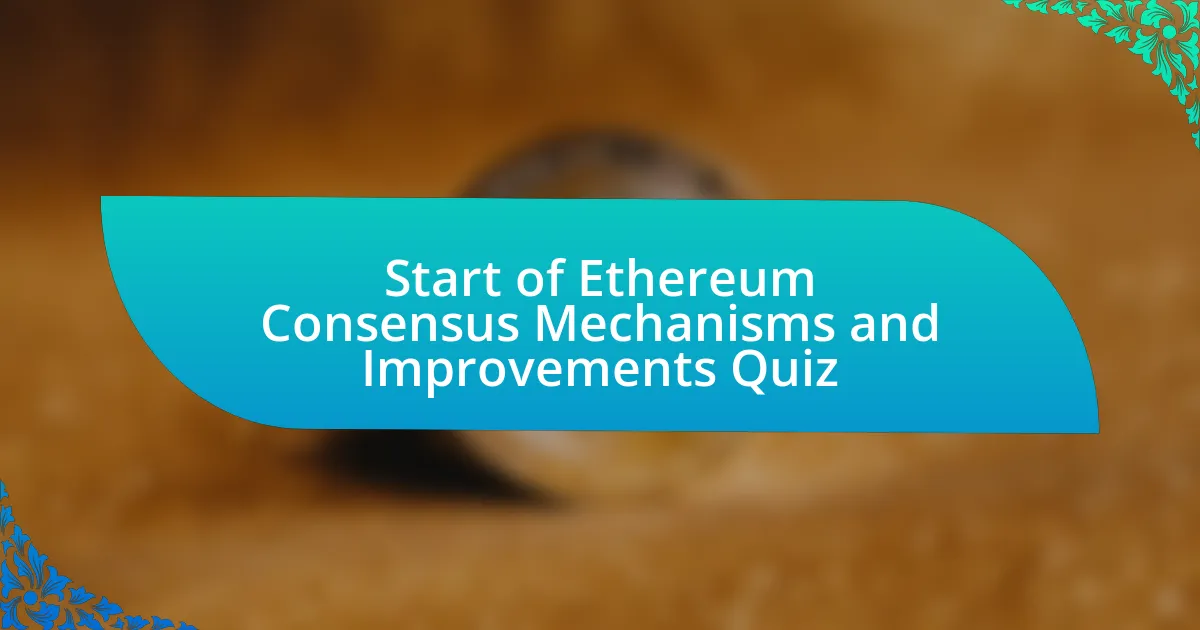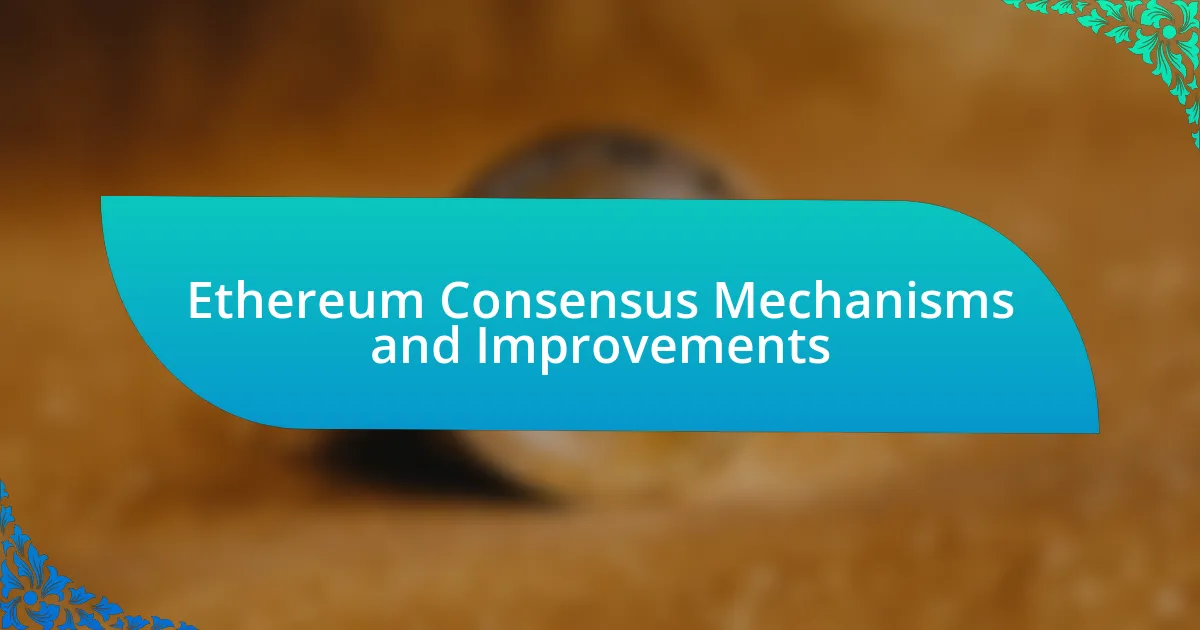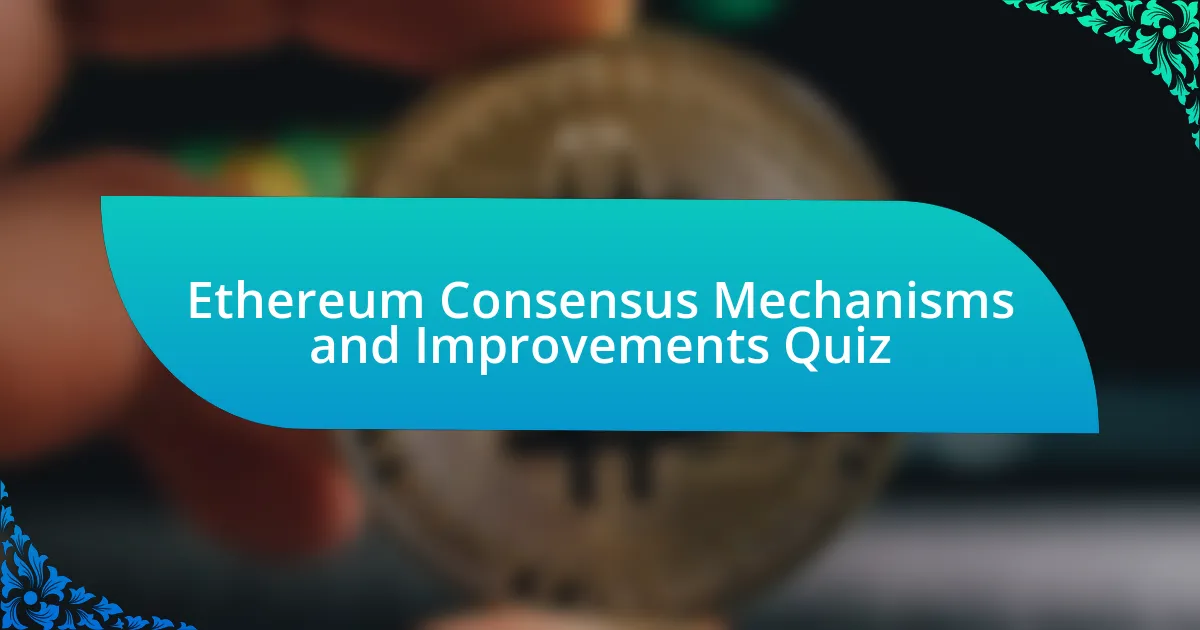
Start of Ethereum Consensus Mechanisms and Improvements Quiz
1. What is a consensus mechanism?
- A method of encrypting messages between users in a network.
- A process for creating new cryptocurrency coins from existing ones.
- A technique to gather data from multiple sources for analysis.
- A protocol that brings all nodes of a distributed blockchain network into agreement on a single data set.
2. How do nodes input data in a consensus mechanism?
- Nodes input data from a pending transaction, then report back with an approval or disapproval status once the request is cross-checked with its records.
- Nodes input data by manually entering information in the system.
- Nodes input data randomly and create blocks without checks.
- Nodes input data by receiving instructions from a central authority.
3. What happens if a node wants to challenge the record in a consensus mechanism?
- The node would ignore the record entirely.
- The node would automatically accept the record.
- The node would have to request a network-wide recall.
- The node would create a duplicate transaction.
4. What is an example of consensus mechanisms in action?
- The score required to win a match.
- The colors used in a video game.
- The way humans agree on the rules of a game.
- The number of players in a board game.
5. What is the primary goal of a consensus mechanism?
- To eliminate all forms of central authority in networks.
- To create a single point of failure in blockchain systems.
- To make transactions faster than any other system.
- To reach an agreement or consensus among peers about the state of the distributed ledger technology (DLT).
6. Which consensus algorithm does Ethereum currently use?
- Practical Byzantine Fault Tolerance (PBFT)
- Proof-of-Stake (PoS)
- Proof-of-Work (PoW)
- Delegated Proof-of-Stake (DPoS)
7. How does Ethereum`s proof-of-stake (PoS) consensus mechanism work?
- Nodes validate transactions every hour and combine them into weekly blocks for rewards.
- Validators create blocks through random selection and transaction proposals, rewarded in ETH.
- Miners compete to solve complex puzzles and update the blockchain, earning rewards.
- Participants take turns creating blocks based on their stake, with fixed rewards distributed monthly.
8. What is the fork-choice mechanism in Ethereum`s PoS consensus?
- The fork-choice mechanism randomly selects blocks for validation.
- The fork-choice mechanism allows any block to become final.
- The fork-choice mechanism rejects blocks not created by miners.
- The fork-choice mechanism selects blocks based on staked ether weight.
9. What is the purpose of the fork-choice algorithm in Ethereum?
- To define the maximum block size for transactions processed.
- To decide which chain is the `correct` chain in cases of multiple possible blocks.
- To create new tokens for network validators.
- To increase the transaction fees for miners processing blocks.
10. How does Ethereum`s current consensus mechanism ensure security?
- Ethereum`s PoS consensus mechanism ensures security through a set of rewards and penalties applied to capital locked by stakers.
- Ethereum`s PoS consensus mechanism relies solely on random block generation for security.
- Ethereum`s PoS consensus mechanism guarantees security without any economic incentives.
- Ethereum`s PoS consensus mechanism ensures security through fixed transaction fees alone.
11. What is the difference between Ethereum`s current and previous consensus mechanisms?
- Ethereum now only allows transactions through a centralized authority instead of decentralization.
- Ethereum`s new mechanism requires no rewards for block creation, unlike the previous system.
- Ethereum previously used proof-of-work (PoW) for block creation and now uses proof-of-stake (PoS) with validators.
- Ethereum always used proof-of-stake (PoS) for block creation from the start.
12. What is the Beam Chain proposal for Ethereum`s consensus layer?
- The Beam Chain proposal is a new method for mining Ethereum.
- The Beam Chain proposal replaces the entire Ethereum blockchain.
- The Beam Chain proposal solely focuses on increasing transaction speed.
- The Beam Chain proposal aims to transform Ethereum`s consensus layer with zk proofs and post-quantum cryptography.
13. Why is the Beam Chain proposal necessary?
- To modernize Ethereum`s core infrastructure.
- To improve the mining process of Ethereum.
- To increase transaction fees for users.
- To limit the number of validators in the network.
14. What cryptographic enhancements are part of the Beam Chain proposal?
- symmetric encryption methods
- hash-based consensus algorithms
- traditional block confirmations
- zk proofs and post-quantum cryptography
15. How does the Beam Chain proposal improve staking in Ethereum?
- The Beam Chain proposal increases the minimum staking requirement to 64 ETH, limiting access to only wealthy users.
- The Beam Chain proposal eliminates the need for staking entirely, allowing anyone to participate freely.
- The Beam Chain proposal restricts staking to only institutional investors, excluding individual participants.
- The Beam Chain proposal reduces the minimum staking requirement from 32 ETH to just 1 ETH, making staking more accessible to a larger audience.
16. What is the significance of SNARK-based cryptography in the Beam Chain proposal?
- SNARK-based cryptography reduces the cost of Ethereum transactions.
- SNARK-based cryptography improves transaction speed in all blockchains.
- SNARK-based cryptography allows validators to select preferred zkVM implementations.
- SNARK-based cryptography eliminates the need for validators altogether.
17. What is the role of FOCIL in the Beam Chain proposal?
- FOCIL eliminates validators to improve speed.
- FOCIL enhances censorship resistance with isolated validators.
- FOCIL reduces the block size for faster transactions.
- FOCIL manages transaction fees among all nodes.
18. How does the Beam Chain proposal address Maximal Extractable Value (MEV) mitigation?
- The Beam Chain proposal prevents any forms of transaction ordering on the network.
- The Beam Chain proposal includes improvements in MEV mitigation through its design choices, though specific details are not provided in the sources.
- The Beam Chain proposal ensures MEV is maximized for all transactions on the network.
- The Beam Chain proposal eliminates all MEV-related activities in Ethereum completely.
19. What is the expected timeline for implementing the Beam Chain proposal?
- 2030
- 2028
- 2025
- 2035
20. Who introduced the Beam Chain proposal?
- Charles Hoskinson
- Gavin Wood
- Justin Drake
- Vitalik Buterin
21. What is the primary focus of the Beam Chain proposal?
- Enhance censorship resistance, improve staking mechanisms, and incorporate cryptographic enhancements.
- Focus solely on lowering fees for transactions on Ethereum.
- Increase transaction speeds while removing validators.
- Streamline user interface and improve wallet accessibility.
22. How does the Beam Chain proposal enhance decentralization in Ethereum?
- The Beam Chain proposal centralizes decision-making by limiting validators to a single execution client.
- The Beam Chain proposal aims to decentralize block production further by introducing isolated validators with execution auctions and faster slots.
- The Beam Chain proposal increases the minimum required ETH to become a validator to ensure fewer participants.
- The Beam Chain proposal focuses on enhancing profitability by reducing transaction fees for validators.
23. What is the significance of RISC-V in the Beam Chain proposal?
- RISC-V has become the de facto standard of zkVMs in the Beam Chain proposal, allowing for flexibility in zkVM implementations.
- RISC-V is a hardware component that reduces transaction fees drastically.
- RISC-V is solely responsible for Ethereum mining rewards.
- RISC-V`s role is to eliminate the need for validators in the network.
24. What is the purpose of the `snarkification` in the Beam Chain proposal?
- To reduce transaction fees during staking
- To simplify the consensus protocol for developers
- To increase the number of validators on the network
- To leverage zero-knowledge proofs for security
25. How does the Beam Chain proposal address technological debt in Ethereum?
- The Beam Chain proposal focuses on enhancing user interfaces rather than core technology improvements.
- The Beam Chain proposal focuses solely on improving transaction speed without addressing underlying issues.
- The Beam Chain proposal aims to address technological debt by incorporating new research and improvements in succinct non-interactive argument of knowledge (SNARK) technology.
- The Beam Chain proposal eliminates all historical code entirely to start fresh.
26. What is the role of Maximal Extractable Value (MEV) mitigation in the Beam Chain proposal?
- The Beam Chain proposal completely eliminates MEV by redesigning Ethereum`s fee structure.
- MEV mitigation is not addressed in the Beam Chain proposal at all.
- The Beam Chain proposal includes improvements in MEV mitigation, though specific details are not provided in the sources.
- MEV mitigation in the Beam Chain proposal focuses solely on increasing transaction fees.
27. What is the expected impact on validator participation with the Beam Chain proposal?
- Decreasing validator participation.
- Keeping validator participation the same.
- Potentially increasing validator participation.
- Eliminating validator participation completely.
28. How does the Beam Chain proposal ensure flexibility in zkVM implementations?
- The Beam Chain proposal mandates that all validators use the same zkVM implementation to ensure uniformity.
- The Beam Chain proposal eliminates the use of zkVMs entirely, focusing only on traditional architectures.
- The Beam Chain proposal restricts validators to a single zkVM implementation based on RISC-V architecture.
- The Beam Chain proposal ensures flexibility by allowing validators to select their preferred zkVM implementations, whether based on RISC-V or other architectures.
29. What is the significance of post-quantum cryptography in the Beam Chain proposal?
- Post-quantum cryptography makes Ethereum completely immune to all attacks.
- Post-quantum cryptography eliminates the need for consensus mechanisms in Ethereum.
- Post-quantum cryptography is used solely for transaction speed improvements.
- Post-quantum cryptography ensures Ethereum`s resilience against quantum threats.
30. How does the Beam Chain proposal improve block production in Ethereum?
- The Beam Chain proposal reduces block sizes to improve transaction speeds.
- The Beam Chain proposal only focuses on enhancing the Ethereum wallet interface.
- The Beam Chain proposal aims to decentralize block production further by introducing isolated validators with execution auctions and faster slots.
- The Beam Chain proposal limits validator participation to only large stakeholders.

Quiz Successfully Completed!
Congratulations on completing the quiz about Ethereum Consensus Mechanisms and Improvements! We hope you found the questions engaging and informative. This quiz offered insights into the complexities of Ethereum’s consensus models, including proof of work and proof of stake. Understanding these concepts is crucial in the rapidly evolving blockchain landscape.
Participating in this quiz likely enhanced your understanding of how consensus mechanisms operate and their significance in securing the Ethereum network. You may have learned about the benefits and challenges of various approaches, and how they contribute to network efficiency and scalability. Such knowledge is increasingly valuable as the Ethereum ecosystem continues to develop.
If you’re eager to deepen your understanding further, we invite you to explore the next section on this page. This section provides additional information on Ethereum’s consensus mechanisms and improvements. With more detailed explanations and examples, it will help consolidate your learning and expand your knowledge on this vital topic. Dive in and continue your journey into the world of Ethereum!

Ethereum Consensus Mechanisms and Improvements
Understanding Ethereum Consensus Mechanisms
Ethereum’s consensus mechanisms are vital for maintaining the integrity and security of the network. They define how nodes reach agreement on the state of the blockchain. Initially, Ethereum utilized Proof of Work (PoW), which requires extensive computational power to validate transactions. However, this model faced criticism for its energy consumption and scalability issues. In response, Ethereum transitioned to Proof of Stake (PoS) with the Ethereum 2.0 upgrade, aiming for improved efficiency and reduced environmental impact.
Proof of Work (PoW) in Ethereum
Proof of Work (PoW) was the original consensus mechanism used by Ethereum,. Under this system, miners solve complex mathematical problems to validate transactions and create new blocks. This process, while secure, is resource-intensive, requiring significant amounts of electricity. PoW ensures decentralization but has led to concerns regarding its sustainability and scalability. The network faced congestion during high-demand periods, limiting transaction throughput.
Transition to Proof of Stake (PoS)
The transition from Proof of Work to Proof of Stake (PoS) began with Ethereum 2.0, also known as Serenity. PoS relies on validators who lock up a certain amount of Ether as collateral to be selected for block validation. This mechanism vastly reduces energy consumption since it does not require extensive computational work. It enhances network security through economic incentives, as validators risk their staked Ether if they act maliciously. The shift to PoS aims to facilitate greater scalability and efficiency within the network.
Benefits of Proof of Stake
Proof of Stake presents several benefits over the previous PoW model. It drastically lowers the energy requirements, making Ethereum more environmentally friendly. PoS also increases transaction throughput by allowing more blocks to be created in a shorter time frame. Economic security is enhanced, as validators have a vested interest in the network’s integrity. Moreover, the potential for centralization is decreased, ensuring a more decentralized network. These improvements address many concerns associated with the PoW system.
Future Improvements in Ethereum’s Consensus Mechanism
Following the transition to PoS, Ethereum continues to explore enhancements in its consensus mechanism. The development of sharding is one major focus, which aims to improve scalability by allowing parallel transaction processing across different segments of the blockchain. Additionally, ongoing research into hybrid mechanisms could blend the strengths of both PoW and PoS. Layer 2 solutions are also being developed to improve transaction speeds and reduce costs. These future improvements aim to bolster Ethereum’s capacity to handle a growing number of users and use cases.
What are Ethereum Consensus Mechanisms?
Ethereum consensus mechanisms are protocols that ensure all nodes in the Ethereum blockchain network agree on the state of the ledger. The main consensus mechanism used by Ethereum is Proof of Stake (PoS), which was implemented during the Ethereum 2.0 upgrade known as “The Merge” in September 2022. This shift from the previous Proof of Work (PoW) system significantly decreased energy consumption by over 99%, enhancing sustainability and scalability.
How does Ethereum’s Proof of Stake work?
In Ethereum’s Proof of Stake system, validators replace miners. Validators are chosen to create new blocks based on the number of coins they hold and are willing to “stake” as collateral. This process reduces computational power requirements and allows for quicker transaction confirmations, with block creation every 12-14 seconds compared to the longer times seen in Proof of Work systems.
Where can I find Ethereum’s consensus mechanism updates?
Ethereum’s consensus mechanism updates can be found on the official Ethereum Foundation website and through Ethereum Improvement Proposals (EIPs). Significant changes and technical details are documented in these proposals. Community discussions related to updates are also prevalent on platforms like GitHub, Discord, and forums such as Reddit.
When did Ethereum transition from Proof of Work to Proof of Stake?
Ethereum transitioned from Proof of Work to Proof of Stake on September 15, 2022, during an event referred to as “The Merge.” This historic upgrade marked the completion of Ethereum 2.0’s first phase, ultimately leading to a more energy-efficient and scalable network.
Who governs changes to Ethereum’s consensus mechanisms?
Changes to Ethereum’s consensus mechanisms are governed by a decentralised community, primarily consisting of developers and stakeholders. Decisions are made through a collaborative process involving Ethereum Improvement Proposals (EIPs), which allow anyone to propose changes. Validators also play a crucial role by signaling their support for proposed upgrades during governance discussions.

